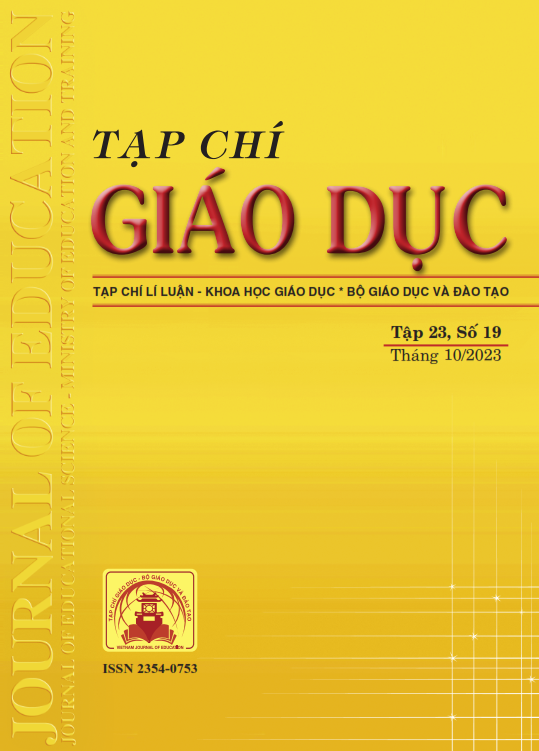Các yếu tố ảnh hưởng tới sự chủ động và hứng thú học tập của sinh viên Trường Đại học Giáo dục - Đại học Quốc gia Hà Nội trong lớp học đảo ngược
Tóm tắt
The flipped classroom is a method that encourages flexible, active learning and autonomy in class. Learners are provided with learning materials, and videos before class meetings and subsequently have opportunities to interact with lecturers, discuss in groups, and carry out activities to enhance their knowledge and skills. This study investigates factors affecting first-year- students’ learning initiative and interest in flipped classrooms. The responses collected via Google Forms were analyzed using PLS-SEM. The results reveal that the benefits and skill enhancement through the flipped classroom model significantly impacted the students’ learning initiative and interest. In contrast, the student satisfaction was statistically insignificant.
Tài liệu tham khảo
Albert, M., & Beatty, B. J. (2014). Flipping the classroom applications to curriculum redesign for an introduction to management course: Impact on grades. Journal of Education for Business, 89(8), 419-424. https://doi.org/10.1080/08832323.2014.929559
Alqasa, K. M. A., & Afaneh, J. A. A. (2022). Active Learning Techniques and Student Satisfaction: Role of Classroom Environment. Eurasian Journal of Educational Research (EJER), 98(2022), 85-100.
Baytiyeh, H. (2017). The flipped classroom model: when technology enhances professional skills. The International Journal of Information and Learning Technology, 34(1), 51-62 https://doi.org/10.1108/ijilt-07-2016-0025
Cho, H. J., Zhao, K., Lee, C. R., Runshe, D., & Krousgrill, C. (2021). Active learning through flipped classroom in mechanical engineering: Improving students’ perception of learning and performance. International Journal of STEM Education, 8, 1-13. https://doi.org/10.1186/s40594-021-00302-2
Deng, F. (2020). Research on the Flipped College English Class Based on “Knowledge Internalization”. Journal of Language Teaching and Research, 11(3), 467-472.
Đỗ Tùng, Hoàng Công Kiên (2020). Áp dụng mô hình lớp học đảo ngược trong dạy học trực tuyến tại Trường Đại học Hùng Vương. Tạp chí Khoa học và Công nghệ, Trường Đại học Hùng Vương, 19(2), 37-45.
Estes, M. D., Ingram, R., & Liu, J. C. (2014). A review of flipped classroom research, practice, and technologies. International HETL Review, Volume 4, Article 7. https://www.hetl.org/a-review-of-flipped-classroom-research-practice-and-technologies/
Fornell, C., & Larcker, D. F. (1981). Evaluating structural equation models with unobservable variables and measurement error. Journal of Marketing Research, 18(1), 39-50. https://doi.org/10.2307/3151312
Hair Jr, J. F., Hult, G. T. M., Ringle, C. M., & Sarstedt, M. (2021). A primer on partial least squares structural equation modeling (PLS-SEM). Sage Publications.
Hair, J. F., Hult, G. T. M., Ringle, C. M., Sarstedt, M., & Thiele, K. O. (2017). Mirror, mirror on the wall: a comparative evaluation of composite-based structural equation modeling methods. Journal of the Academy of Marketing Science, 45, 616-632. https://doi.org/10.1007/s11747-017-0517-x
Hair, J. F., Risher, J. J., Sarstedt, M., & Ringle, C. M. (2019). When to use and how to report the results of PLS-SEM. European Business Review, 31(1), 2-24. https://doi.org/10.1108/ebr-11-2018-0203
Hair, J., & Alamer, A. (2022). Partial Least Squares Structural Equation Modeling (PLS-SEM) in second language and education research: Guidelines using an applied example. Research Methods in Applied Linguistics, 1(3), 100027. https://doi.org/10.1016/j.rmal.2022.100027
Henseler, J., Hubona, G., & Ray, P. A. (2016). Using PLS path modeling in new technology research: Updated guidelines. Industrial Management & Data Systems, 116(1), 2-20. https://doi.org/10.1108/imds-09-2015-0382
Hu, L. T., & Bentler, P. M. (1999). Cutoff criteria for fit indexes in covariance structure analysis: Conventional criteria versus new alternatives. Structural Equation Modeling: a Multidisciplinary Journal, 6(1), 1-55. https://doi.org/10.1080/10705519909540118
Kanelopoulos, J., Papanikolaou, K. A., & Zalimidis, P. (2017). Flipping the classroom to increase students’ engagement and interaction in a mechanical engineering course on machine design. International Journal of Engineering Pedagogy (iJEP), 7(4), 19. https://doi.org/10.3991/ijep.v7i4.7427
Leão, P., Coelho, C., Campana, C., & Viotto, M. H. (2022). Flipped classroom goes sideways: Reflections on active learning methodologies. Revista de Gestão, 30(2), 207-220. https://doi.org/10.1108/rege-04-2021-0066
Martínez-Jiménez, R., & Ruiz-Jiménez, M. C. (2020). Improving students’ satisfaction and learning performance using flipped classroom. The International Journal of Management Education, 18(3), 100422. https://doi.org/10.1016/j.ijme.2020.100422
McLaughlin, J. E., Roth, M. T., Glatt, D. M., Gharkholonarehe, N., Davidson, C. A., Griffin, L. M., ... & Mumper, R. J. (2014). The flipped classroom: a course redesign to foster learning and engagement in a health professions school. Academic Medicine, 89(2), 236-243. https://doi.org/10.1097/ACM. 0000000000000086
Nouri, J. (2016). The flipped classroom: For active, effective and increased learning - especially for low achievers. International Journal of Educational Technology in Higher Education, 13(1). https://doi.org/10.1186/s41239-016-0032-z
O’Connor, N. (2021). Using active learning strategies on travel and tourism higher education programmes in Ireland. Journal of Hospitality, Leisure, Sport & Tourism Education, 29, 100326. https://doi.org/10.1016/j.jhlste.2021.100326
Roemer, E., Schuberth, F., & Henseler, J. (2021). HTMT2–an improved criterion for assessing discriminant validity in structural equation modeling. Industrial Management & Data Systems, 121(12), 2637-2650. https://doi.org/10.1108/IMDS-02-2021-0082
Velegol, S. B., Zappe, S. E., & Mahoney, E. M. I. L. Y. (2015). The Evolution of a Flipped Classroom: Evidence-Based Recommendations. Advances in Advances in Engineering Education, 4(3), 1-37.
Tải xuống
Đã Xuất bản
Cách trích dẫn
Số
Chuyên mục
Giấy phép

Tác phẩm này được cấp phép theo Ghi nhận tác giả của Creative Commons Giấy phép quốc tế 4.0 .












